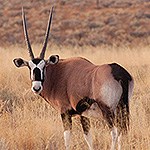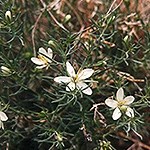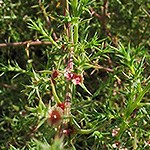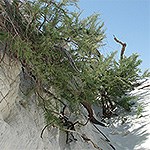
NPS Photo
The spread of invasive species is recognized as one of the major factors contributing to ecosystem change and instability throughout the world. An invasive species is defined as "a non-native species whose introduction does, or is likely to cause, economic or environmental harm or harm to human, animal, or plant health." Invasive species include all taxa of organisms, ranging from microscopic insects to 100 pound sheep, and can invade any ecosystem, from river beds to lava fields. These species have the ability to displace or eradicate native species, alter fire regimes, damage infrastructure, and threaten human livelihoods. Invasive species are changing the iconic landscapes of our national parks. Here at White Sands National Park, we have several invasive species that are impacting the environment.

NPS Photo Oryx gazella Here at White Sands, there is only one known invasive animal species: the African oryx. A native of the Kalahari Desert in southern Africa, the oryx, or gemsbok (Oryx gazella), is a large antelope that was introduced to southern New Mexico by the New Mexico Department of Game & Fish. Between 1969 and 1977, 95 oryx were released on White Sands Missile Range and in the surrounding areas with the purpose of developing a population for public hunting. Learn more… 
NPS Photo Peganum harmala African rue originated in North Africa and deserts of Asia. It was imported into New Mexico in the late 19th century and was first recognized as an invasive species near Deming, New Mexico, in the 1920s. African Rue is extremely tolerant of drought and can grow in many types of soil, including alkaline and saline soils. The plant can spread rapidly into disturbed areas such as roadsides and desertified rangelands. It is highly toxic to both humans and animals if eaten; however, dehulled seeds do produce edible oil that is very similar to cottonseed oil. Learn more… 
NPS Photo Salsola kali Russian thistle is commonly referred to as tumbleweed, a plant often associated with America’s western landscape in movies and even songs. Despite this, tumbleweeds are not actually native to the American West. This invasive plant was first found in the U.S. in the state of South Dakota in the 1870s. It probably hitchhiked in sacks of seed grain from the steppes near Russia’s Ural Mountains. Once here, the Russian thistle traveled quickly, taking root in areas disturbed by agriculture and accompanying irrigation in the arid western states. By 1900, it was widespread in the western U.S. in fields and roadside ditches. Although it can be a food source for native animals, Russian thistle is generally considered a noxious weed. Learn more... 
NPS Photo Tamarix spp. The plant genus Tamarix is comprised of about 54 species, all of which are native to North Africa, the Mediterranean, and the Middle East. Popularly called by its common names tamarisk or saltcedar, this plant usually grows as a woody shrub or small tree in areas where water is at or near the surface. Since its introduction to the Tularosa Basin in the 1850s, tamarisk has quickly spread into natural wetlands, where it tends to form a dense monoculture along riparian ecosystems, displacing native plants such as cottonwood, willow, and mesquite. At White Sands National Park, tamarisk has invaded many interdunal areas where the water table is high, ultimately choking out native vegetation. It also threatens the White Sands Pupfish, which naturally occurs only in a few springs and one stream in the Tularosa Basin, by threatening to dry up the pupfish's habitat. Learn more... |
Last updated: January 30, 2020
